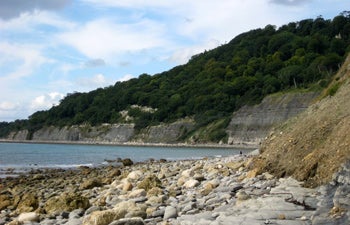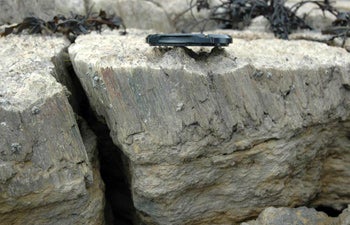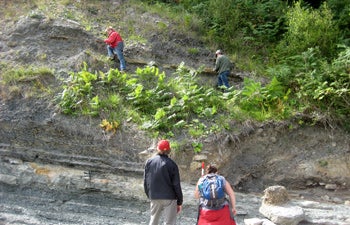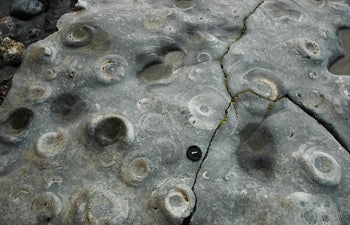Stories Set in Stone
When four members of the USC College Department of Earth Sciences took a fieldwork expedition to the United Kingdom, they didn’t have to venture out in the middle of nowhere, drive on dirt roads for hours or hike miles to get to their destination.
Instead, they walked along the scenic coastline of southern England, where families frolicked on the beach and tourists scrambled over dinner-plate-sized fossil ammonites to look for treasures in the rock. The group even went out for ice cream when the rising tides chased them away from the cliffs they were examining.
“Usually you think of scientists doing fieldwork somewhere remote, but here, we were in a cultured, civilized area,” said David Bottjer, professor of earth sciences and biological sciences. “It was still an adventure. We had some predictions about what we might find, and we found those and more.”
Bottjer, along with Frank Corsetti, associate professor of earth sciences, and graduate students Sarah Greene and Yadira Ibarra spent two weeks abroad in August 2010 looking for evidence of an ancient ocean acidification crisis.

Cliffs on the Lyme Regis coast. Photo credit Yadira Ibarra.
The England trip was inspired by an earlier field study that took Bottjer, the chair of the Department of Earth Sciences, and Greene to Canada in 2008 to study layers of rock representing the Triassic–Jurassic extinction event. This extinction occurred nearly 200 million years ago, wiped out about half of the living species including the majority of aquatic life, and may have paved the way for dinosaurs to dominate the Earth.
“One of the reasons we’re interested in this global mass extinction is that it might have been due to something similar to what’s happening today,” Bottjer said.
When carbon dioxide is released into the air, the gas is absorbed by the ocean, creating carbonic acid and making the water more acidic. At the time of the Triassic–Jurassic extinction, volcanoes released the carbon dioxide into the air, whereas today, fossil-fuel-burning humans are the culprit.
Although there is still much debate about the causes of this mass extinction, the earth sciences group believes that there is a link between ocean acidification and the extinction. By studying this ancient event, the team hopes to develop a better idea of how acidification might affect ocean ecosystems in the future.
While Bottjer and Greene were exploring an outcropping of rock at Williston Lake in British Colombia that contained these extinction layers, they discovered very strange layers of rock made of calcium carbonate. After returning to USC, Greene discovered descriptions in a few scientific papers of a similar rock found in England that the locals called “beef” due to the rock’s thin, vertical striations that resemble a slab of steak.

Exposed beef, a layer of vertical striations made of calcium carbonate, with a camera lens cap for size comparison. Photo credit Frank Corsetti.
“Originally, we thought this was a late crack filling, unrelated to the extinction,” Greene said. “But now we don’t think that’s what happened at all.”
Instead of a layer that formed millions of years later as the layers of rock split apart, Greene and the earth sciences team propose that beef may have formed just after the sediment was deposited, resulting from excess dissolved calcium carbonate in the ocean.
With the help of a National Science Foundation grant, Bottjer, Corsetti and Greene scheduled a trip to England to gather samples of beef to explore their theory, and to find out if ancient ocean acidification was a global phenomenon.
Second-year earth sciences graduate student Ibarra, who studies stromatolites in California lake areas, joined Bottjer, Corsetti and Greene on the trip. Stromatolites, which form in ocean floor sediment like beef, are finely-layered structures that are a product of microbial activity, and many scientists consider them to be the oldest fossils on Earth.
So the group set off for a two-week tour of England and Wales, planning to visit sites where the ancient sediments are exposed hoping to find both beef and stromatolites. College alumnus Michael Lewis, who received his Ph.D. from the Department of Earth Sciences in 2008, met the team in England as their official British host.
Operating out of a 19th-century house, they made daily excursions to locales such as St Audrie’s Bay and Lavernock Point, where they had to time their beef-collecting trips with the tides. When the tides were in their favor, they explored the exposed cliffs, where they chiseled away at the stone and collected samples of beef.

The team searches for beef in St Audrie’s Bay. Photo credit Yadira Ibarra.
According to Greene’s theory, beef is formed during times of ocean acidification that can also inhibit an organism’s ability to create shells.
“At Williston Lake in Canada, there are no shells surrounding the extinction interval. Even though there was a mass extinction, there should be shells leading up to it and after it,” Corsetti said. “However, beef is made out of the same materials as shells.”
They hypothesize that the dissolved calcium carbonate from the shells partially re-precipitated as layers of beef in a process called diagenesis, the change that sediment undergoes after its initial deposition.
“We’re suggesting that there might be information in diagenesis that’s relevant,” Greene said. “It’s a new place to look at mass extinction events.”
If the theory is correct, the layer of beef may serve as a reminder of the devastating results of ocean acidification.
Later in the England trip, in the famous fossil town Lyme Regis, the group had hoped to find Ibarra’s stromatolites in the exposed cliffs, but had no such luck.

David Bottjer and Frank Corsetti explore the rocky Lyme Regis coast. Photo credit Yadira Ibarra.
“So we went into town where there were fossil shops, and we joked around about asking for stromatolites,” Ibarra said. “Sure enough, in one shop, in the farthest room, they had one in the corner.”
After purchasing the fossil shop example, they tracked down the seller, who directed them to an abandoned quarry. There, in the interval representing the Triassic–Jurassic extinction, they finally found stromatolites in the wild.
For Ibarra, it was exhilarating to find the rock at an extinction site. “It’s a sign of a stressful environment if these structures can form in the shallow sea,” Ibarra said. In an extinction period, microbes would flourish because aquatic animals would not be alive to eat them.

Ammonite fossil beds at Lyme Regis. Photo credit Frank Corsetti.
When the group returned from their trip, they brought with them 200 pounds of beef and stromatolites to continue their study at USC, which they believe will show, among other things, that the sediments were formed during the mass extinction, and therefore that the acidification of the ocean had a severe impact on the ecosystem at that time.
“What kind of story will the rocks tell us about what was going on at this time?” Ibarra asked.
Both Greene and Ibarra hope to publish papers based on their findings abroad. And both agreed that trips such as this make their work unique and exciting.
“Being able to do research in places like England is what attracted me to geology in the first place. I’ve been able to go all over the world,” Greene said.
Their research into the causes and effects of ocean acidification has just begun, Bottjer said. “There are other trips to be had. The detective story continues.”